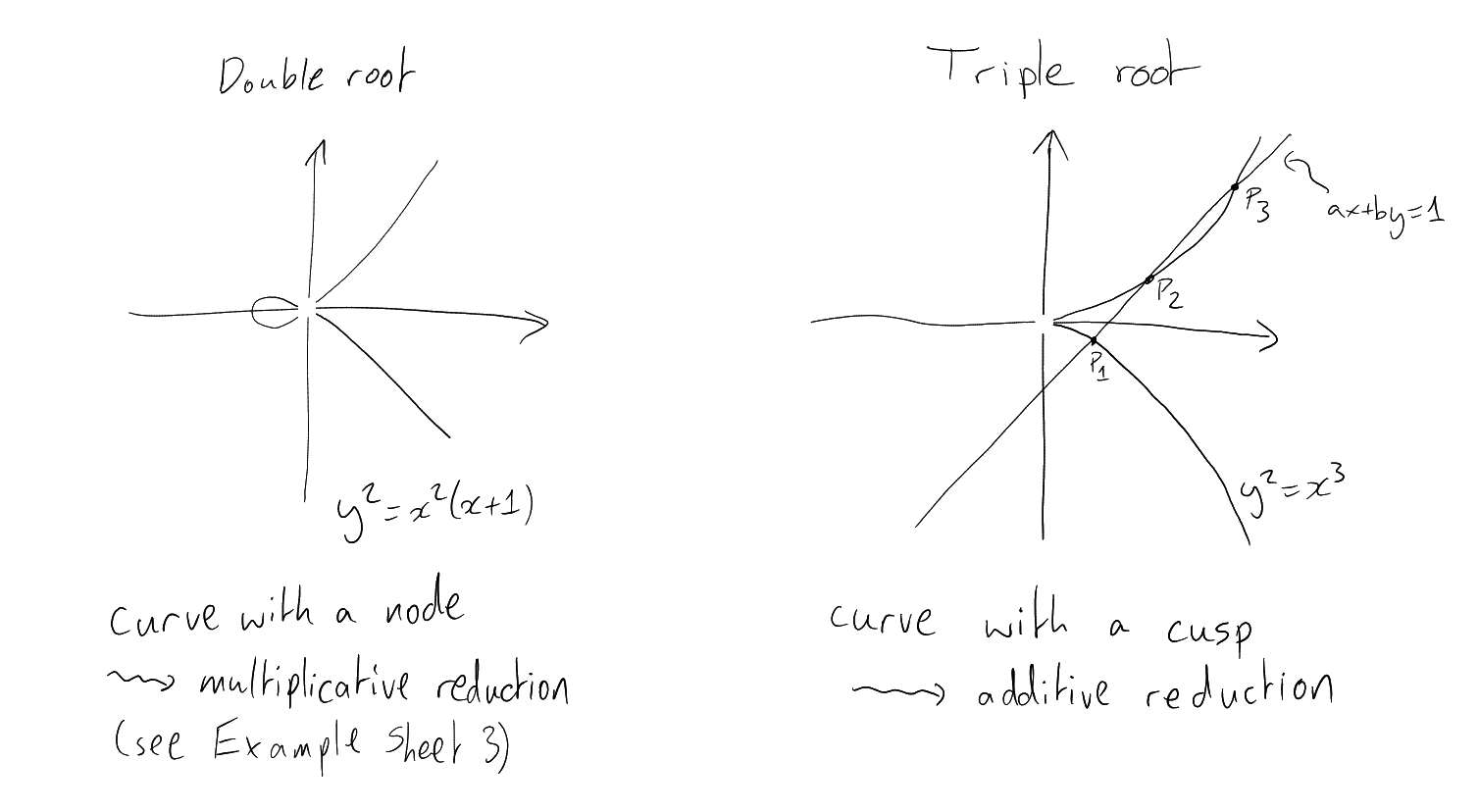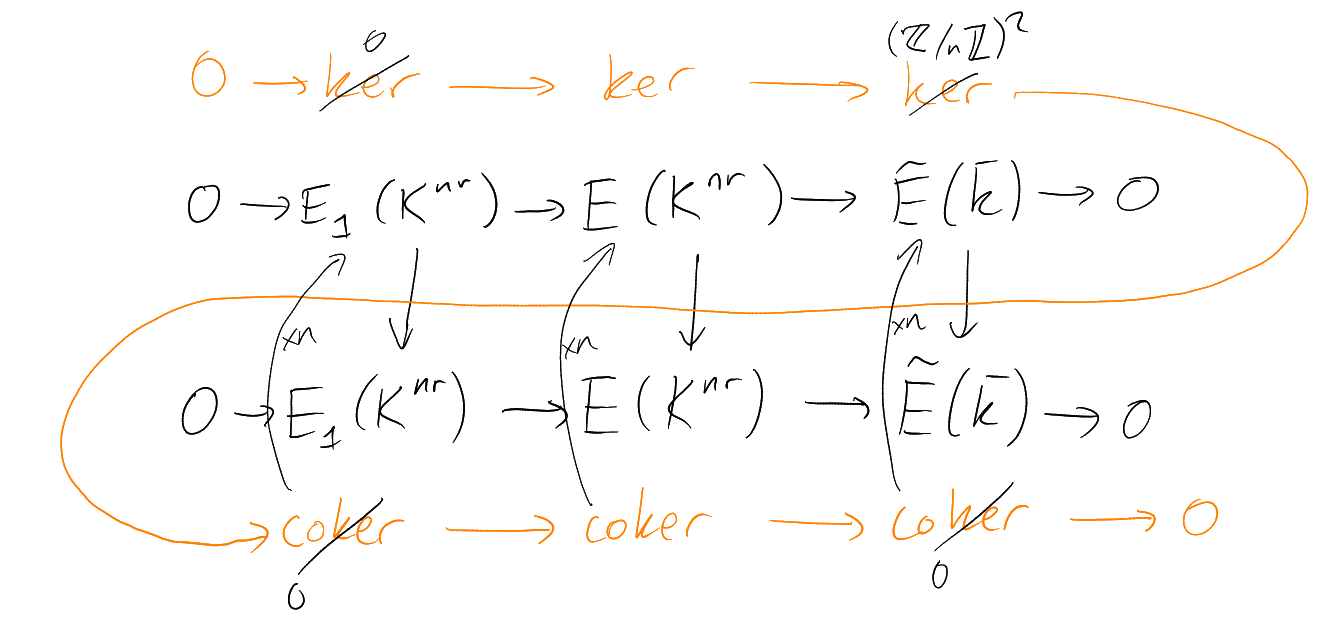9 Elliptic Curves over Local Fields
Let be a field, complete with
respect to discrete valuation .
Notation.
Valuation ring (= ring of integers) will be denoted by
Unit group will be denoted by
The maximal ideal will be denoted by
where .
The residue field will be denoted by .
We assume
and . For
example, ,
,
.
Let be
an elliptic curve.
Definition (Integral / minimal Weierstrass equation).
A Weierstrass equation for
with coefficients
is integral if
and minimal if
is minimal among all integral Weierstrass equations for .
Lemma 9.1.
Assuming that:
Then either
or
for some .
(Compare with Q5 from Example Sheet 1)
Proof.
Throughout this proof, LHS and RHS refer to the Weierstrass equation of the curve.
Case :.
If
then
and .
Therefore .
Case :
and .
We get 3 possible inequalities from this, and each of them gives .
Now
so
for some .
□
If is complete,
then is complete
with respect to
(for any ).
We fix a minimal Weierstrass equation for .
Get formal group Ê
over .
Taking
(with )
in Lemma 8.2 gives
Ê
By Lemma 8.2 this is a subgroup of ,
say .
More generally, for
a formal group over
We claim that
-
for
sufficiently large.
-
for .
Reminder: ,
.
Theorem 9.2.
Assuming that:
Then
is an isomorphism of groups with inverse
|
|
Remark.
,
.
Proof.
For
we must show the power series
and
converge to elements in .
Recall
|
|
for some .
Claim: .
Proof of claim:
|
|
Therefore
(we go from
to by noting that
the LHS is in ).
This proves the claim.
Now
This is always
and as
. Therefore
converges to
an element in .
Same method works for .
□
Lemma 9.3.
for all
.
Proof.
Definition of formal group gives
So if ,
|
|
Therefore
is a surjective group homomorphism with kernel .
□
Corollary.
Assuming that:
Then has a subgroup of
finite index isomorphic to .
Notation.
Reduction modulo
Proposition 9.4.
Assuming that:
Proof.
Say Weierstrass equations are related by ,
,
.
Then .
Both equations minimal gives us that ,
hence .
Transformation formula for the
and
is integrally closed, hence .
The Weierstrass equations obtained by reducing mod
are now related by ũ,
ũ,
.
□
There is a well-defined map
ỹ
(choose a representative with ).
We restrict to give
Ẽ
If then
by Lemma 9.1 either
-
in which case ỹ.
-
or ,
for some ,
in which case
and .
Therefore
|
|
“kernel of reduction”.
Notation.
|
ẼẼ |
The chord and tangent process still defines a group law on
Ẽ.
In cases of bad reduction, Ẽ
(over or possibly a
quadratic extension of )
or Ẽ (over
).
For simplicity we suppose .
Then Ẽ,
.
Ẽ↤↤
Let
lie
on the line
.
Write
,
. Then
. So
. So
are the
roots of
.
Looking at coefficient of
gives .
Definition ().
Ẽ.
Proposition 9.5.
is a
subgroup of and reduction
modulo is a surjective
group homomorphism Ẽ.
Note.
If
has good reduction, then this is a surjective group homomorphism
Ẽ.
Proof.
Group homomorphism: A line
in defined
over
has equation
We may assume .
Reduction modulo
gives a line
If
with
then these points lie on a line .
So
lie on the line .
If
then .
So if
then
and .
[Exercise: check this still works if ]
Surjective: Let .
Let Ẽ,
say ỹ
for some .
Since
non-singular, either:
-
(i)
.
-
(ii)
.
If (i) then put .
Then
Hensel’s lemma gives us that there exists
such that
Then has
erduction .
asdfadsf □
Recall that for
we put
|
|
If , these
give:
|
ÊÊ |
where for , each
gives a quotient
isomorphic to .
We have Ẽ.
What about ?
Lemma 9.6.
Assuming that:
Then
has finite index.
Proof.
implies that
is finite for all .
Hence
is a profinite group, hence compact.
Then is
the union of sets
|
|
and hence compact (for the -adic
topology).
Now note
is a closed subset, hence compact.
So
is a compact topological group.
If Ẽ has a
singular point ỹ
then
|
|
is a closed subset of
hence
is an open subgroup of .
The cosets of
are an open cover of .
Hence .
□
Definition (Tamagawa number).
is called the Tamagawa number.
We deduce:
Theorem 9.7.
Assuming that:
Then contains a subgroup of
finite index isomorphic to .
Let and
a finite extension. Let
the residue fields be
and ,
and let .
Facts:
-
(i)
.
-
(ii)
If
is Galois then the natural map
is surjective with kernel of order .
Definition (Unramified).
is unramified if .
Fact: For each
-
(i)
has a unique extension of degree
(say ).
-
(ii)
has a unique unramified extension of degree
(say ).
These extensions are Galois, with cyclic Galois groups.
Definition (Maximal unramified extension).
(inside ).
“maximal unramified extension”
Theorem 9.8.
Assuming that:
Notation.
|
|
where .
Proof.
For each
there is a short exact sequence
Taking
gives a commutative diagram with exact rows:
An isomorphism by Corollary 8.5 applied over each
(using
here).
Snake lemma gives
|
|
So if then
there exists
such that
and
|
|
Hence
and so
is unramified. □

